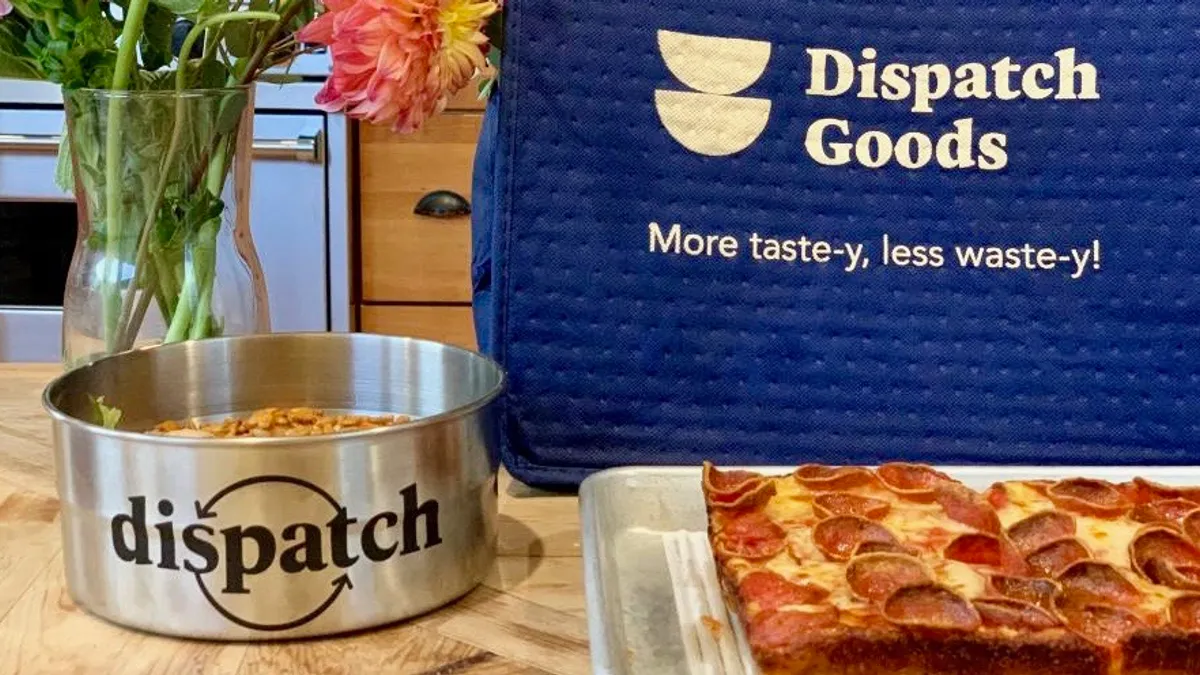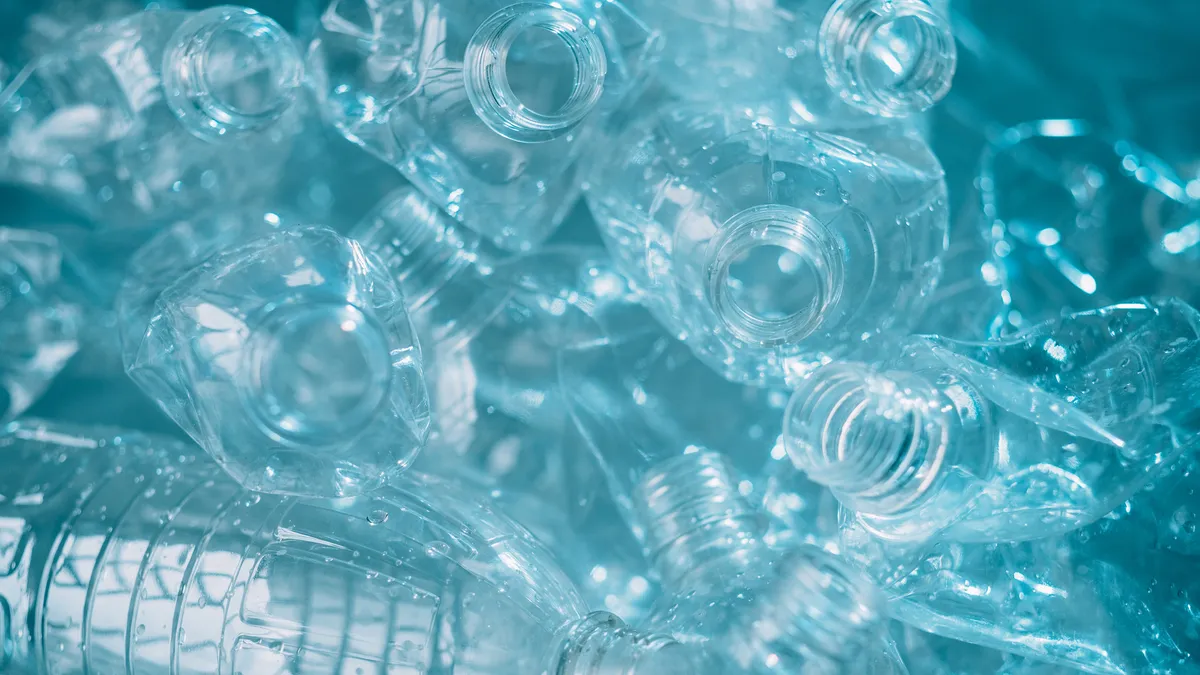As reliance on takeout food grows thanks to the coronavirus pandemic — and with it, the amount of waste generated by every meal — one Bay Area restaurant is exploring an alternative by making reusable packaging a mandatory part of the off-site dining experience.
Prior to the pandemic, takeout made up just a small part of the weekly routine at full-service restaurant Zuni Café in San Francisco. It would go through about 150 takeout boxes in a week.
Now, under California’s most recent coronavirus restrictions on indoor and outdoor dining, Zuni's usage has increased by more than 100%. The rise in material waste worried chef and owner Nate Norris, but at the same time it was far from his biggest concern.
“This is not something that I was walking around trying to figure out, ‘Well, how do we get to reusable?’” said Norris. “If I was to talk with a restaurant peer about this, it would be like, ‘You can't focus on that right now. How can you possibly focus on that?’”
Despite this, Zuni launched a partnership in December with local reusable container service Dispatch Goods to prepare all meals in packaging that can be returned, cleaned and redistributed.
While some might view it as a risky experiment, the move comes at a time of unique opportunity for circular economy pilots. Pandemic restrictions have created an unparalleled shift in how and where people consume, and residential waste volumes remain up by an average of 5% or more nationally as a result.
That uptick in takeout packaging waste is taking a toll, with much of it a challenge to recycle, and some say now is the time to develop alternatives that will stick.
Downstream implications of disposability
As manufacturers see a rise in demand for packaging products, and use this surge to advocate for the value of disposables during a pandemic, they recognize the waste implications of takeout are a work in progress.
“To-go packaging has seen a massive surge as people are trying to buy from their local restaurants,” said Paul Frantz, chief commercial officer at Novolex, a corporation that owns a number of companies responsible for manufacturing takeout containers. “Packaging is playing a critical role in being able to deliver high-quality, high-value food to a consumer who has expectations that it's going to arrive in good shape, arrive hot, and not leaking."
This shift in the market has been highly visible to Frantz. Pre-pandemic, for example, Novolex's biggest seller was a nine-inch plate – a sign of the important role on-site cafeterias played in the daily routines of millions of corporate office workers. Today, he said, rigid plastic and compostable clamshells — the iconic containers that hinge two halves together to form a portable vessel for takeaway meals — “are now the number one seller, absolutely."
But the rise in material consumption also comes with downstream costs.
“When human behavior shifts, when there are cultural shifts and demographic shifts, we see it,” said Joe Fusco, a vice president at Vermont-based waste and recycling company Casella Waste Systems. Anecdotally, he said, “we're seeing more of that takeout container kind of waste.”
Comprehensive studies quantifying the waste generated by takeout and restaurant delivery in the United States are hard to come by. But a September report in the journal Nature Food saw researchers consider waste from food delivery in China, a sector which it said has grown from $3.37 billion in 2011 to $43.6 billion in 2019.
Using data from 353 cities serviced over a six-month period by the online food delivery platform Meituan, researchers estimated that even before the pandemic (in 2018) 10 billion takeout orders serving 406 million customers generated 676 million pounds of waste. That was enough, they said, to fill 456 World Cup stadiums.
In the U.S., said Fusco, much of that will end up in landfills or incinerators due to challenges capturing or recycling many types of takeout packaging.
Though Novolex is working toward 100% recyclability or compostability of its products, Frantz said that infrastructure still lags far behind. And even if products can be recycled, food residue contamination is an ongoing issue for the takeout category.
“We want to see a world where there's as little that goes into a landfill as absolutely possible,” he said, but “there is absolutely a need to build out the recycling infrastructure, which in this country, is still underdeveloped from our perspective.”
Katrin Molina-Besch, an associate senior lecturer at Lund University’s Department of Design Sciences who reviewed the China study, agreed with its conclusions about alternatives to packaging waste. Using life cycle assessments, researchers found reusable takeout containers could offer a distinct environmental advantage over just switching from plastic to paper or compostable packaging.
At least in Sweden, where Molina-Besch is based, interest in such a program appears to be very high — even during a pandemic, when single-use manufacturers have played into consumers’ fears over hygiene and sanitation. A December survey funded by the company Svenska Retursystem, found that of 1,000 Swedish nationals, 70% said they would be willing to transport takeout food in their own reusable lunch boxes.
“Often, when you talk about the environmental impact of packaging, it's only about: ‘Okay, it's a certain material, and it will become waste. And therefore, we should try to avoid it,’” said Molina-Besch, “But especially for food, it is a bit more complicated.”
In grocery retail (her primary area of research) she has found that extending the life of the food — which has its own high environmental and production costs — is imperative. As a result, packaging in this sector must not only be durable enough to traverse very long distances, but also well-insulated to accommodate a longer shelf life before consumption. This requires more three-dimensional life cycle analyses of grocery packaging. Whereas for takeout packaging it's considered to justifiable to focus more concretely on the potential for waste generation, or avoidance, because there aren't the same concerns about preservation and durability.
“It's basically just a container,” said Molina-Besch. "You just put in the food and deliver it to people's homes.”
A new model
Zuni Café is not the first foodservice establishment to explore reusable takeout options. In 2019, New York chain Dig piloted a reusable bowl. Last fall, McDonalds announced a refillable cup pilot with TerraCycle’s Loop in the UK. Burger King shortly followed suit, also offering a reusable Whopper package.
In all cases, however, customers still have the option to decline reuse in favor of more familiar disposable products. Pilots have also been limited to specific packaging types, like a coffee cup or a bowl.
The partnership between Dispatch Goods and Zuni is unique in that it will serve all orders in reusable containers. The cost of Dispatch’s service is not immediately visible to customers, but is built into price adjustments for a few high-volume menu items. Being a higher-end restaurant, Norris said, means “the additional costs, in terms of a percentage of what we charge our customers for our food and service, would be small compared to if we were maybe a more fast casual restaurant with lower prices.”
The effect the mandatory nature of the program will have on return rates for containers is unclear. Other reusable services, like Loop, have previously gone to great lengths to ensure a high level of returns from users through methods including cash deposits, money-back programs and tracking technology. Some say foregoing these measures is a risk.
“It's very encouraging to see the deployment of reusable packaging as a practical and convenient alternative to single-use packaging,” said Elizabeth Balkan, North American director for circular consulting firm Reloop. Without a financial incentive, Balkan worries about the “unintended consequence of creating more emissions-intensive reusable packaging: a concerningly imperfect replacement for single-use packaging.”
While Zuni's Norris believes patrons will support the initiative — the restaurant’s commitment to sustainability is seen as a reason they come in the first place — he also recognized “they're not actively choosing this. We chose it, and it's being thrust upon them." At the same time, he said, “I think that we don't get to the solution without working through the problems.”
In the past, Dispatch Goods has partnered with delivery app DoorDash to offer reusable packaging as an add-on (for $1.99 per item) at partnering restaurants. Dispatch CEO and Co-founder Lindsey Hoell said the downtown corporate lunch surge was their biggest pre-pandemic market, as it offered a stable, sedentary and consistent customer base that could easily return packages.
“Our mission is to be the ‘fourth bin’ in office spaces,” she said, referencing recycling, organics, and other waste. Until recently, the company's return rate for packaging was 92%.
Tracking is a challenge because there aren’t unique codes on each container, something she hopes to change in the near future. The company was mostly getting same-day returns, since people were dropping off at their offices, and collecting them in bulk. But the pandemic dealt a huge blow to the lunchtime market.
With the traditional workforce at home, the logistics of container returns have changed. Now, Dispatch has pivoted to mostly curbside collections from homes across the city, which are scheduled in advance via text.
“It was basically a one-day turnover. Now it's more like a one-week turnover,” said Hoell, noting this is why the fee is non-refundable. “You’re paying for a service.” Customers using the service frequently can also purchase a $20 monthly subscription.
For the partnership with Zuni, customers can return their packaging — which includes steel tins with silicone lids for meals and mason jars for drinks (cutlery is not currently included) — by scheduling a home pickup via text, or by returning directly to the restaurant itself.
Scaling up
The partnership is still in its earliest stages, but both Hoell and Norris are pleased with the response so far. Dispatch Goods serviced 1,708 containers in the first week, which is nearly double a typical week for the restaurant. Norris was careful to note the change wasn't directly comparable, due to initial sizing differences for the reusable containers and the fact that California's dining restrictions took effect on the pilot's first day.
What Hoell hopes for next is to prove the concept at a greater scale. Dispatch Goods currently services reusables for 16 restaurants in San Francisco, including Zuni, and the new logistics of home collection are challenging.
According to Molina-Besch, the kind of scale needed to make circular programs most efficient is best facilitated by municipal partnerships, not unlike other public services such as recycling. Without that involvement, there is a limit to how many restaurants may get on board.
“These packaging decisions are such a minor thing for [restaurants]. So you cannot really expect that they put a lot of energy or resources into this. It's just how they deliver their food,” she said. “But the city or region that has the waste problem, they have an interest in getting another solution. So then they probably also should be the ones initiating.”
Hoell says that while she works with San Francisco on certain fronts, it’s not yet in an official capacity. “It doesn't seem like there's an appetite for creating another public utility, and picking a winner in the space,” she said. “That's kind of what happened with recycling and I think there's been some backlash."
As for how this fits into the bigger picture of waste and recycling, Norris said the "actual real world impact" of his restaurant switching to reusable packaging may be small but he feels the decision to do this – particularly during a crisis — sends an important message to consumers.
“[We need to] answer the problem of how do we get the person that's not the super good, environmental steward opt-in person,” he said, “How do we get that person to be the participant we need them to be? And that's part of the process we're engaged in right now.”





















